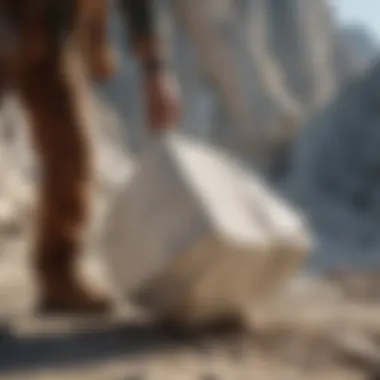Unveiling the Wonders of Marble Rock Formations: A Comprehensive Guide to Exploration


Rock and Fossil Identification
Get ready to embark on an enlightening journey into the captivating realm of marble rock formations and gain a profound understanding of their formations. When exploring marble rocks near you, it is essential to be equipped with the knowledge of various types of rocks and fossils that you may encounter. From the distinctive veining patterns of marble to the presence of embedded fossils, there are plenty of unique characteristics to look out for. Utilizing specialized tools for identification, such as magnifying glasses and rock hammers, can enhance your ability to discern the specific types of marble rocks and fossils you come across.
Collecting Tips and Techniques
For avid rock and fossil collectors seeking to delve into the world of marble rocks, it is crucial to familiarize yourself with best practices for collecting. Identifying prime collecting sites is key, as certain locations may yield more abundant or unique specimens. Exercise caution and employ proper techniques when extracting specimens to ensure their integrity and your safety. Consulting with local geological experts or joining rockhounding clubs can provide valuable insights into optimal collecting methods and safety precautions to follow.
Preservation and Display
Once you have amassed a collection of marble rocks and fossils, preserving them effectively becomes paramount. Employing techniques such as labeling, wrapping, and storing specimens in suitable containers can aid in their long-term preservation. Considerations such as humidity levels and temperature control play a vital role in maintaining the integrity of your collection. When it comes to displaying your prized finds, explore creative ideas such as shadow boxes, themed showcases, or interactive exhibits to showcase the beauty and diversity of marble rocks and fossils in a visually appealing manner.
Geological Insights
Delve into the geological wonders encapsulated within marble rock formations and gain a comprehensive understanding of the processes that have shaped these natural marvels. Uncover the historical significance of specific rocks and fossils, and learn about notable discoveries that have contributed to the field of geology. Explore the intricate nexus between geology, paleontology, and archaeology, and marvel at the wealth of knowledge waiting to be unearthed in the fascinating world of marble rocks. Embrace the opportunity to expand your geological insights and appreciate the enduring allure of these remarkable formations.
Introduction to Marble Rocks
In the realm of geology, exploring marble rocks unveils a world of intrigue and wonder. The Introduction to Marble Rocks sets the stage for this geological adventure, priming enthusiasts and rock collectors for a journey filled with discovery and fascination. Whether delving into the depths of metamorphic processes or unraveling the symbolic threads woven into marble's cultural significance, this section serves as a gateway to a deeper understanding of these majestic rocks. Through meticulous detail and insightful analysis, readers are invited to embark on a captivating exploration of the geological marvels that marble rocks embody.
Understanding the Formation of Marble
Marble, with its origins rooted in a complex metamorphic process, exhibits a transformational journey unlike any other rock formation. The Metamorphic Process lies at the core of marble’s creation, shaping its distinctive qualities and characteristics. This process not only underscores the resilience and durability of marble but also highlights its aesthetic allure, making it a sought-after choice for architectural and artistic endeavors. Moreover, the Composition and Characteristics of marble offer a fascinating glimpse into its rich diversity and structural intricacies, presenting a tapestry of colors, patterns, and textures that captivate the eye and intrigue the mind.
Metamorphic Process
At the heart of marble's formation lies the Metamorphic Process, a metamorphosis of sedimentary limestone through intense heat and pressure. This transformative journey imbues marble with unparalleled strength and elegance, making it a versatile choice for construction and sculptural purposes. The unique veining patterns and stunning color variations produced by this process distinguish marble as a premier choice for those seeking both durability and aesthetics in their geological pursuits.
Composition and Characteristics


Examining the Composition and Characteristics of marble reveals a mosaic of elements that contribute to its allure and utility. From its mineral composition to its crystalline structure, marble embodies a harmonious blend of minerals that bestow upon it unique colors and veining patterns. This intricate makeup not only enhances marble's aesthetic appeal but also influences its hardness, durability, and suitability for various applications, making it a prized material in both architectural and artistic realms.
Significance of Marble in Geology
Delving deeper into the world of marble unveils its profound significance in the geological landscape. Beyond its physical attributes, marble's role in Architectural Uses showcases its versatility and adaptability in building iconic structures and monuments. Its symbolism in Art and Culture further elevates marble to a status of timeless beauty and significance, bridging the realms of geology and human creativity. By exploring marble's architectural and symbolic dimensions, enthusiasts gain a holistic appreciation for these enduring rocks that transcend mere geological formations.
Locating Marble Rock Deposits
Geological Regions Known for Marble
Marble in the United States
Marble in the United States represents a significant aspect of the global marble industry. Its contribution to the overall topic of exploring marble rocks is substantial due to the diverse range of marble types found in various states. The key characteristic of Marble in the United States is its varying colors and patterns, making it a popular choice for collectors and researchers alike seeking unique specimens. One distinctive feature of Marble in the United States is its high quality and durability, making it particularly beneficial for architectural and artistic purposes. However, the transportation costs associated with some remote quarries could be considered a slight disadvantage in certain contexts within this article.
Iconic Marble Quarries Worldwide
Exploring Iconic Marble Quarries Worldwide offers a rich perspective on the historical and cultural significance of marble extraction across different continents. The key characteristic of these quarries is their legacy of producing some of the most sought-after marble varieties in the world, attracting enthusiasts and scholars interested in geological heritage. Their benefit lies in the exquisite quality and geological uniqueness of the marble extracted from these sites, making them a favored choice for inclusion in this article. A unique feature of Iconic Marble Quarries Worldwide is the vast array of color variations and veining patterns present in the marble, providing a diverse range of options for rock collectors. Nevertheless, the environmental impact of quarrying activities may pose certain disadvantages that are also acknowledged in the context of this article.
Tools and Resources for Rock Hunting
Geological Maps
Geological Maps serve as indispensable tools for enthusiasts embarking on marble rock hunting expeditions. Their contribution to this guide is immense as they allow individuals to pinpoint specific marble-rich regions, understand geological formations, and plan efficient routes for exploration. The key characteristic of Geological Maps is their detailed depiction of geological features, including marble deposits, enabling enthusiasts to make informed decisions about their rock hunting expeditions. Their benefits include aiding in the identification of potential marble sources and guiding enthusiasts towards fruitful geological exploration. A unique feature of Geological Maps is the utilization of color-coded legends to differentiate between various rock types, enhancing the efficiency of locating marble deposits. However, a potential disadvantage could arise from outdated map information leading to inaccurate location data, an aspect that enthusiasts should be wary of when using Geological Maps.
Online Databases
Online Databases have revolutionized the way rock collectors and geology enthusiasts access information about marble rock deposits worldwide. Their significance to this article lies in the vast repository of data they offer, ranging from geological surveys to user-generated content on marble occurrences. The key characteristic of Online Databases is their accessibility and convenience, allowing enthusiasts to research marble-rich regions, geological compositions, and even engage with a community of fellow rock enthusiasts. A beneficial aspect of Online Databases is the real-time updates and interactive features that enhance the user experience in discovering marble sources for exploration. A notable feature of Online Databases is the integration of mapping tools and search filters that streamline the process of locating marble deposits. However, potential disadvantages may include data reliability issues or discrepancies that users should be cautious of when relying on Online Databases for rock hunting endeavors.
Exploration and Identification of Marble Rocks


Field Guide to Marble Rock Features
Color Variations
Color variations play a vital role in the allure of marble rocks, offering a spectrum of hues that reflect the mineral composition and environmental conditions during their formation. From pristine whites to striking blacks, each color variation tells a story of the geological forces at play. Understanding these color variations enhances the exploration experience, allowing collectors to appreciate the diverse aesthetics of marble specimens. While vibrant colors may captivate the eye, subtle hues often reveal the delicate nuances of a specimen's history, making color variations a key aspect in identifying and appreciating marble rocks.
Veining Patterns
Veining patterns are like nature's fingerprints on marble rocks, showcasing intricate designs that add character and charm to each piece. These patterns result from mineral deposits and geological events that occurred over millennia, creating unique swirls and lines that mesmerize collectors. Veining patterns not only contribute to the visual appeal of marble but also serve as identifiers for specific types of marble and the regions they originate from. By studying these patterns closely, rock enthusiasts can unravel the stories embedded within each marble rock, making veining patterns a crucial element in the exploration and identification process.
Tools for Rock Identification
Magnetic Testing
Utilizing magnetic testing techniques is essential for rock collectors to identify the magnetic properties of marble rocks. This method aids in distinguishing between various types of marble based on their magnetic responses, providing valuable insights into their mineral composition and origin. Magnetic testing offers a non-destructive means of classification, enabling enthusiasts to catalog their specimens with precision and accuracy.
Acid Reaction Tests
Acid reaction tests prove to be indispensable in the toolkit of rock collectors, allowing them to determine the chemical composition of marble rocks. By observing the reaction of marble to different acids, collectors can ascertain crucial information about the presence of specific minerals within the specimen. This analysis aids in categorizing marble rocks according to their geological characteristics, facilitating a deeper understanding of their formation and history. Acid reaction tests equip enthusiasts with the tools needed to unravel the geological mysteries concealed within marble rocks, making them an invaluable asset in the exploration and identification process.
Preservation and Display of Marble Specimens
Cleaning and Maintenance Tips
Gentle Cleaning Techniques
Gentle Cleaning Techniques play a pivotal role in the upkeep of marble rock specimens. The delicacy of marble requires gentle care to prevent damage and maintain its natural luster. Utilizing soft brushes, mild soaps, and careful techniques help remove dirt and grime without harming the specimen. The key characteristic of Gentle Cleaning Techniques lies in their ability to cleanse without causing abrasions or altering the specimen's appearance. Their gentle nature ensures that the marble remains unscathed, making them a popular choice among collectors seeking to preserve their specimens. While Gentle Cleaning Techniques are highly beneficial for maintaining the integrity of marble rocks, cautious handling is essential to avoid any potential disadvantages such as overlooking tougher stains or persistent marks.
Storage Recommendations


Storage Recommendations are essential for safeguarding marble specimens when not on display. Proper storage ensures protection from environmental factors that could harm the specimens over time. Adequate padding, humidity control, and sheltering from direct sunlight are key characteristics of sound Storage Recommendations. By following proper storage protocols, collectors can prolong the lifespan of their marble specimens and prevent any inadvertent damage. The unique feature of Storage Recommendations lies in their ability to maintain the condition of specimens while in storage. While advantageous for preserving marble rocks, improper storage can lead to deterioration due to exposure to unfavorable conditions. Implementing suitable storage strategies outlined in this article will help collectors safeguard their valuable marble specimens effectively.
Creative Display Ideas
Creative Display Ideas serve as vibrant expressions of admiration and education for marble rock collections. By incorporating innovative display concepts, collectors can accentuate the beauty and uniqueness of marble specimens. These displays not only enhance the aesthetic appeal but also offer educational value to viewers, highlighting the geological significance of marble. Let's explore the specific aspects of Mounting Options and Illumination Effects in the context of this article for an enriched display experience.
Mounting Options
Choosing suitable Mounting Options is essential for showcasing marble specimens effectively. Mounts can range from elegant stands to custom framing, accentuating the specimen's features and providing stability during display. The key characteristic of Mounting Options lies in their ability to elevate the visual presentation of marble rocks, making them a popular choice among collectors seeking to enhance their displays. Their unique feature of versatility allows for various mounting styles tailored to individual preferences. While advantageous for displaying marble specimens, improper mounting could detract from the specimen's allure and compromise the viewer's appreciation. Selecting appropriate Mounting Options as outlined in this article will ensure a captivating and secure display of marble rocks.
Illumination Effects
Implementing Illumination Effects can dramatically enhance the visual impact of marble rock displays. Strategic lighting illuminates key features of the specimens, highlighting their colors, textures, and intricate details. The key characteristic of Illumination Effects lies in their ability to create a dynamic visual experience that captivates viewers and accentuates the beauty of marble rocks. Their unique feature of transformative lighting effects adds depth and dimension to displays, captivating audiences and fostering a deeper appreciation for the geological marvels of marble. While beneficial for enhancing the overall presentation, excessive illumination may cause glare or overshadow certain details. By applying appropriate Illumination Effects as suggested in this article, collectors can create captivating displays that showcase the splendor of marble specimens to their fullest potential.
Community Engagement and Further Resources
In the realm of exploring marble rocks, community engagement plays a pivotal role in fostering a rich and vibrant network of like-minded enthusiasts. The essence of community engagement lies in the shared passion for geology, creating a platform for knowledge exchange, exploration collaboration, and mutual support. This article emphasizes the significance of building connections within the rockhounding community to enhance the overall experience and learning opportunities for enthusiasts. By actively engaging with fellow rock collectors and geology aficionados, individuals can deepen their understanding of marble rocks, discover new hunting locations, and participate in group expeditions to uncover rare specimens.
Joining Rockhounding Groups
Local Clubs
Local clubs serve as fundamental pillars of the rockhounding community, offering enthusiasts a dedicated space for interaction, education, and collective adventures. These clubs often organize field trips, workshops, and guest lectures, providing members with valuable insights into marble rock formations, identification techniques, and preservation practices. The key characteristic of local clubs lies in their ability to unite individuals with a shared enthusiasm for geology, creating a supportive environment for beginners and experienced collectors alike. Joining a local club can be a beneficial choice for those seeking guidance, camaraderie, and access to exclusive geological sites. The unique feature of local clubs is the sense of belonging and camaraderie they provide, fostering lifelong friendships and enriching the rockhounding experience.
Online Forums
Online forums offer a virtual platform for rockhounds to connect, share knowledge, and seek advice from a global community of enthusiasts. These forums serve as hubs of information exchange, where members discuss marble rock hunting tips, identify unknown specimens, and engage in lively discussions about geological phenomena. The key characteristic of online forums is their accessibility and inclusivity, catering to individuals from diverse backgrounds and geographical locations. Participating in online forums can be a popular choice for enthusiasts looking to engage with a wider network of rock collectors, exchange ideas, and stay updated on the latest trends in the world of geology. The unique feature of online forums is the convenience of connecting with like-minded individuals worldwide, transcending physical boundaries and creating a dynamic space for learning and exploration.
Recommended Reading and Websites
Geological Publications
Geological publications serve as treasure troves of in-depth research, case studies, and analysis related to marble rock formations, geological structures, and mineralogy. These publications contribute significantly to the understanding of marble's properties, origins, and geological significance, offering rock enthusiasts a comprehensive source of information. The key characteristic of geological publications is their academic rigor and specialized focus, presenting readers with expertly curated content that delves into the complexities of marble geology. Choosing geological publications as a resource can be a beneficial choice for readers seeking in-depth knowledge, theoretical insights, and scientific perspectives on marble rocks. The unique feature of geological publications is their role in advancing scholarship in the field of geology, presenting cutting-edge research and discoveries that shape the way we perceive and study marble formations.
Rock Collecting Blogs
Rock collecting blogs provide a more casual and personal approach to exploring the world of marble rocks, offering readers firsthand accounts, field reports, and practical tips from experienced collectors. These blogs contribute to the democratization of geology knowledge, making complex concepts more accessible and engaging to a wider audience. The key characteristic of rock collecting blogs is their storytelling aspect, blending scientific information with anecdotes, unique discoveries, and hands-on experiences in the field. Opting for rock collecting blogs as a resource can be a popular choice for individuals interested in a more relatable and immersive exploration of marble rocks. The unique feature of rock collecting blogs is their capacity to connect readers on a personal level, sparking curiosity, passion, and a sense of shared adventure in the pursuit of geological marvels.







